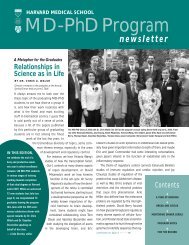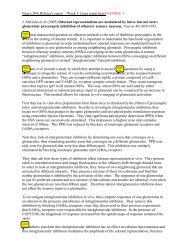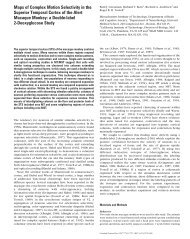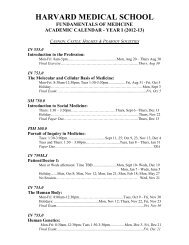Livingstone & Hubel - Harvard Medical School
Livingstone & Hubel - Harvard Medical School
Livingstone & Hubel - Harvard Medical School
You also want an ePaper? Increase the reach of your titles
YUMPU automatically turns print PDFs into web optimized ePapers that Google loves.
Segregation of Form, Color, Movement, andDepth: Anatomy, Physiology, and PerceptionAnatomical and physiological observations in monkeysindicate that the primate visual system consists of severalseparate and independent subdivisions that analyze differentaspects of the same retinal image: cells in corticalvisual areas 1 and 2 and higher visual areas are segregatedinto three interdigitating subdivisions that differ in theirselectivity for color, stereopsis, movement, and orientation.The pathways selective for form and color seem to bederived mainly from the parvocellular geniculate subdivisions,the depth- and movement-selective componentsfrom the magnocellular. At lower levels, in the retina andin the geniculate, cells in these two subdivisions differ intheir color selectivity, contrast sensitivity, temporal properties,and spatial resolution. These major differences inthe properties of cells at lower levels in each of thesubdivisions led to the prediction that different visualfunctions, such as color, depth, movement, and formperception, should exhibit corresponding differences.Human perceptual experiments are remarkably consistentwith these predictions. Moreover, perceptual experimentscan be designed to ask which subdivisions of the systemare responsible for particular visual abilities, such asfigurdground discrimination or perception of depth fromperspective or relative movement-functions that mightbe difficult to deduce from single-cell response properties.separate parts whose functions are quite distinct. In this article wesummarize some of these anatomical, physiological, and humanperceptualobservations.Physiological and Anatomical StudiesOccasionally people with strokes suffer surprisingly specific visuallosses-for example, loss of color discrimination without impairmentof form perception, loss of motion perception without loss ofcolor or form perception, or loss of face recognition without loss ofthe ability to recognize most other categories of objects or loss ofcolor or depth perception (1). Such selectivity seems to indicate thatthe visual pathway is functionally subdivided at a fairly gross level.Anatomical and physiological studies in monkeys also supportthis idea of functional divergence within the visual pathway. Theyreveal major anatomical subdivisions at the earliest peripheral stagesin the visual system as well as segregation of function at the highestknown cortical stages, but until recently there was little informationabout corresponding subdivisions in the intermediate levels, the firstand second cortical visual areas.Subdivisions at early stages in the miualpathway. It has been knownfor a century that the nerve fibers leaving the eyes diverge to provideinput both to the lateral geniculate bodies and to the superiorcolliculi. The colliculus seems to be relatively more important inlower mammals than it is in primates, in which its main role isprobably orientation toward targets of interest; here we will bePEOPLEWITH NORMAL COLOR VISION WILL PROBABLY FINDthe left illustration in Fig. 1 less clear and three-dimensionalthan the one on the right. But it springs forth if you look at itthrough a blue filter, such as a piece of colored glass or cellophane.In the left version the gray and yellow are equally bright, orluminant, for the average person, whereas the right version hasluminance-contrast information. The ability to infer distance andthree-dimensional shape from a two-dimensional image is an exampleof a visual fiunction that can use luminance but not colordifferences. Depth from perspective and color perception are thusaspects of vision that seem to be handled by entirely separatechannels in our nervous system.Even though intuition suggests that our vision can plausibly besubdivided into several components--color, depth, movement,form, and texture perception-our perception of any scene usuallyseems well unified. Despite this apparent wholeness, studies ofanatomy, physiology, and human perception are converging towardthe conclusion that our visual system is subdivided into several-- -The authors are members of the faculty, Depamnent of Neurobiology, <strong>Harvard</strong><strong>Medical</strong> <strong>School</strong>, Boston, MA 02115.Fig. 1. The same image at equiluminance (left) and non-equiluminance(right). Depth from perspective, spatial organization, and figurelgroundsegregation are diminished in the equiluminant version. To convinceyourself that the left version does indeed contain the same information as theother, look at it through a piece of blue cellophane or glass. These two colorsmay not be close enough to your eqduminance point to be effective.Changing the light source may help.
Fig. 2. The primate lateral geniculatebody. This six-layered structureis the first stage in the visual systemafter the retina, and it consists oftwo distinct subdivisions, the ventraltwo magnocellular layers and thedorsal four pan~ocellular layers. Thetwo eyes project to different layers inthe interdigitating fashion shown: cindicates layers that are innervatedby the contralateral eye; i indicateslayers with input from the ipsilateraleye.Fig. 3. Receptive fields for(left) typical color-opponentparvocellular geniculateneuron, excited over asmall region by red lightand inhibited over a largerregion by green light and(right) typical broadbandmagnocellular neuron, excited by all wavelengths in the center and inhibitedby all wavelengths in its surround.concerned exclusively with the geniculo-cortical part of the visualsystem, which seems to be directly concerned with visual perception(2)-what we think of as seeing.The primate lateral geniculate body is a six-layered structure, withtwo obviously different subdivisions: the four dorsal, small-cell(parvocellular) layers and the two ventral, large-cell (magnocellular)layers; these two subdivisions differ both anatomically and physiologically.In 1920 Minkowski (3) discovered that each eye projectsto three of the six layers in the peculiar alternating fashion shown inFig. 2: each half-retina is mapped three times onto one geniculatebody, twice to the parvocellular layers and once to the magnocellular,and all six topographic maps of the visual field are in preciseregister (4).The four parvocellular layers seem to be very similar, if notidentical, anatomically and physiologically. But the magno- andparvocellular divisions are profoundly different, implying a majorsplit in the visual pathway. This division is most obvious, and wasfirst recognized, in the geniculate, but it does not originate there;the two geniculate subdivisions receive input from two intermixedbut anatomically distinct types of retinal ganglion cells: type A cellsare larger and project to the magnocellular division, and the smallertype B cells project to the parvocellular division (5). These twosubdivisions of the visual pathway, which we will refer to as magnoand parvo, are distinguishable both anatomically and physiologically.Whether this duality in the visual path arises even earlier, at thebipolar or horizontal cells in the retina, is not known. We can at leastbe reasonably certain that the two components must both derivetheir inputs from the same rods and cones and that the markeddifferences in response properties must therefore depend on the waythe photoreceptor inputs are combined.Though they differ significantly in their response characteristics,the magno and parvo systems do share some basic physiologicalproperties. Their receptive fields (the regions of retina over whichtheir impulse activity can be influenced) are all circularly symmetrical,and about 90% show center-surround opponency (6, 7); somecells are excited (impulse rate speeded up) by illumination of a smallretinal region and inhibited (impulse rate slowed down) by illuminationof a larger surrounding region, whereas others are thereverse, inhibited from the center and excited from the surround.Because of the antagonism between center and surround, largeuniform spots produce feeble responses or none. This centersurroundarrangement is found also at earlier levels, starting with theretinal bipolar cells. Clearly these cells are wired up so as to convertthe information from the photoreceptors into information aboutspatial discontinuities in light patterns. This should not be surprising,since we ourselves are very poor in judging overall levels ofillumination, as anyone who tries doing photography without alight meter well knows-we are lucky if we can come within an fstop (a factor of 2) of the right exposure. On the other hand we candetect a spot that is as little as a few percent brighter or darker thanits immediate surround.The magno and parvo divisions nevertheless differ physiologicallyin four major ways--color, acuity, speed, and contrast sensitivity (7-10).Color. About 90% of the cells in the parvocellular layers of thegeniculate are strikingly sensitive to differences in wavelength,whereas cells in the magnocellular layers are not. The three types ofcones in the primate retina have broad, overlapping spectral sensitivitiesand can be loosely termed red-, green-, and blue-sensitive, toindicate that their peak sensitivities are in the long-, middle-, andshort-wavelength regions of the spectrum. Parvo cells are wavelengthselective because they combine these cone inputs so as ineffect to subtract them (Fig. 3, left). A typical parvo cell may, forexample, receive excitatory inputs to its receptive field center fromred cones only, and inhibitory inputs to its receptive field surroundfrom green cones only. Such a cell will be excited by long wavelengths(reds), inhibited by short wavelengths (blues and greens),and be unresponsive to some intermediate wavelength (yellow).Besides such red-on center, green-off surround cells, most of theother possibilities also occur, most commonly red cones antagonizedby green, and blue versus the sum of red and green (that is, yellow).In contrast to the color selectivity of most parvo cells, magno cells(and also the remaining 10% of the parvo cells) sum the inputs ofthe three cone types, so that the spectral sensitivity curves are broad,and the response to a change in illumination is of the same type,either on or off, at all wavelengths (Fig. 3, right) (11). The magnosystem is thus in effect color-blind: as in black-and-white photography,two different colors, such as red and green, at some relativebrightness will be indistinguishable.Acuity. The second difference between magno and parvo cells isthe size of their field centers. For both systems the average size of thereceptive field center increases with distance from the fovea, consistentwith the differences in acuity between foveal and peripheralvision. Yet at any given eccentricity, magno cells have largerreceptive field centers than parvo cells, by a factor of 2 or 3.Speed. Magno cells respond faster and more transiently than parvocells. This sensitivity to the temporal aspects of a visual stimulussuggests that the magno system may play a special role in detectingmovement. Many cells at higher levels in this pathway are selectivefor direction of movement.Contmt. Shapley et al. (10) found that magno cells are muchmore sensitive than parvo cells to low-contrast stimuli. Both beginto respond when the center and surround brightnesses differ by only1 or 2%, but with increasing contrast magno responses increaserapidly and level off at about 10 to 15% contrast, whereas parvoresponses increase more slowly, and saturate at far higher contrasts.These four major differences between the two subdivisions, incolor, acuity, quickness, and contrast sensitivity, imply that theycontribute to different aspects of vision. Exactly what aspects havebecome clearer recently, with new anatomical techniques that have6 MAY 1988 ARTICLES 741
made it possible to follow these subdivisions farther into the centralnervous system and to correlate them with the response selectivity ofcells at later stages in each subdivision for more abstract stimulusfeatures.Continuation of the madno and parvo subdivisions in visual area 1.The segregation of the two pathways is perpetuated in the primaryvisual cortex (12) (Fig. 4). Cells in the magnocellular geniculatelayers project to layer 4Ca, which projects in turn to layer 4B, whichthen projects to visual area 2 and to cortical area MT. Parvo cellsproject to layer 4CP, and from there the connections go to layers 2and 3, and from there to visual area 2. The parvocellular divisionsplits to form an additional subdivision in the upper layers of visualarea 1. The first evidence for this fUrther subdivision came in 1978when Wong-lley (13) stained visual area 1 for the mitochondrialenzyme cytochrome oxidase and saw alternating regions of light anddark staining. The dark regions are round or oval in sections cutparallel to the surface; they are most prominent in the upper layers(2 and 3) but are also faintly visible in layers 5 and 6. They turnedout to represent pillar-like structures about 0.2 rnm in diameter,spaced 0.5 mm apart (14). We term these structures blobs because oftheir three-dimensional shape. Blobs are found only in the primaryvisual cortex; they occur in all primates that have been looked at, andin the prosimian Galago, but have not been found in other prosimiansor any lower mammals (15).Since layers 2 and 3 receive most of their inputs from parvorecipientlayer 4CP, both the blobs and the interblobs could beconsidered continuations of the parvo subdivision. Nevertheless theblobs should probably be thought of as a separate subdivision,because they have somewhat different inputs and very differentresponse properties from the interblobs (16-18). The visual responseproperties of cells in the blobs suggest that they may alsoreceive magnocellular input (17, 18).Thus by the output stage of visual area 1 the magno systemremains segregated, and the parvo system seems to have split into twobranches. All three subdivisions, rnagnm4Ca+4B, parvc-+4Cp-+interblob, and parvo(+magno?)+4Cp-+blob, then project to visualarea 2.These anatomically defined subdivisions in the primary visualcortex differ from each other in the kinds of visual information theycarry (la), as in earlier stages.In the magno pathway, cells in layer 4B are orientation selective;that is, they respond best to lines of a particular orientation, andmost of them also show selectivity for the direction of movement(18, 19)-for example, a cell preferking horizontal lines may respondwhen an edge is moved upward but not when it moves downward.Like magnocellular geniculate cells, cells in 4B lack color selectivity.In the interblobs, most, perhaps all, cells are also orientationselective. Unlike cells in layer 4B, most are not direction selective;10 to 20% are end-stopped, responding to short but not long line oredge stimuli. The receptive fields are small, and the optimum linethickness is similar to the optimum spot size of cells in the geniculateparvocellular layers at the same eccentricity. This system maytherefore be responsible for high-resolution form perception. Althoughanatomical evidence indicates that the interblob systemreceives its major input from the color-coded parvocellular geniculatelayers, most of the interblob cells are not explicitly color-coded:they show no color opponency and respond well to achromaticluminance contrast borders. Nevertheless, many of them respond toan appropriately oriented color-contrast edge regardless of thecolors forming the edge or the relative brightness of the two colors.Similarly, they usually respond to lines or borders of any brightnesscontrast (light-on-dark or dark-on-light), even though the antecedentgeniculate cells are either on-center or off-center but not both.This suggests that much of the color-coded parvocellular input ispooled in such a way that color contrast can be used to identifyborders but that the information about the colors (including blackversus white) forming the border is lost (20).Blob cells are not orientation selective but are either color orbrightness selective. The blob system thus seems to carry informationcomplementary to the information carried by the interblobsystem. The brightness-selective (non-color-coded or broadband)blob cells have larger receptive field centers than the broadbandgeniculate cells but are otherwise similar-they are either excited orinhibited by small spots of light, and they respond less well to largespots, indicating surround inhibition. These broadband blob cellscould receive input from either the magnocellular geniculate cells orfrom the broadband parvo cells, but the physiological properties ofmany of them would be more consistent with input from the rnagnosystem (17, 18). We assume that the color-opponent blob cellsreceive input from the color-opponent parvocellular geniculate cells,Fig. 4. Diagram of the functional segregation ofthe primate visual system. MT, middle temporallobe; V4, visual area 4; LGN, lateral geniculatebody.Primary visual cortexSCIENCE, VOL. 240
Fig. 5. Section parallel to thesurface through visual areas 1and 2 of a squirrel monkey,stained for cytochrome oxidase.Visual area 1 is on the left; theblobs appear as small rounddots. In Visual area 2 the cytochrome-oxidasestain reveals apattern of alternating thin,thick, and pale stripes.though they differ from them in that their receptive field centers arelarger and their color coding is doubly opponent-they give oppositeresponses to different parts of the spectrum in the center (say, onto red and off to green), and both types of center response arereduced when the spot is made larger.The blob and interblob systems thus work in entirely different andcomplementary ways. Blob cells are explicitly color-coded, excitedby colors in one region of the spectrum and inhibited by others, andnot selective for stimulus orientation. Interblob cells are selective forstimulus orientation but mostly are not color selective, respondingto a line or edge of the correct orientation regardless of its color. Thestrategy of carrying orientation information in a system that mostlypools color information and color-contrast information in a separatesystem that does not carry orientation information is probably moreefficient than having single cells selective for both the orientationand color of a border. Nevertheless, as emphasized earlier, althoughmost of the interblob cells are not overtly color selective, theyprobably receive their inputs from explicitly color-coded parvocellulargeniculate cells and are most likely not color-blind in the sensethat the cells in the magno system probably are. Most interblob cells,even though they lose the information about the colors that form aborder or the sign of the contrast of the border, should respond tocolor-contrast borders in which the two colors are equally bright;such borders would be invisible to magno cells.Visual area 2. The main target of visual area 1 is visual area 2(Brodrnann's area 18), which shows an equally intriguing patternwhen stained for cytochrome oxidase (Fig. 5) (16, 21). Instead ofsmall round dots, tangential sections show a pattern of stripes, muchcoarser than the blobs of visual area 1; these alternately dark andlight stripes are several millimeters wide and run perpendicular tothe border between visual areas 1 and 2, probably extending overthe entire 8- to 10-rnrn width of visual area 2. The dark stripes arethemselves of two types, thick and thin. The regularity of thispattern of thick, thin, and pale stripes varies from animal to animaland is clearer in New World monkeys than in Old World ones, atleast partly because in Old World monkeys visual area 2 is buried inthe lunate sulcus. Given three histologically defined regions in visualarea 2 and the fact that visual area 1 has three kinds of subdivisionsthat project to other cortical areas, it was natural to ask if they wererelated. And indeed, from tracer injections into the three kinds ofstripes in visual area 2, we found that the blobs are reciprocallyconnected to the thin stripes, the interblob regions to the palestripes, and layer 4B to the thick stripes (Fig. 4) (18, 22).The next step was to record from cells in visual area 2, to learnwhether the three subdivisions carry different types of visual information.We did indeed find marked differences, which were consist-6 MAY 1988ent with the properties of cells in the antecedent subdivisions ofvisual area 1 (18, 23).Cells in the thin stri~eshowed no orientation selectivitv. ,,andover half were color-coded, just as we had found in the blobs. As inthe blobs, most of the color-coded cells were doubly opponent, withtwo antagonistic inputs to their centers, and surround antagonismfor both of these center inputs. About half of the thin-stripe cells,both broadband and color 'opponent, exhibited an additional prop:erty not seen in the blob cells: the receptive field centers were bigger,yet optimum spot sizes were about the same. A typical cellmight respond best, say, to a 0.5" diameter spot, give no response atall to 2" or 4" spots (indicating surround antagonism), and yetrespond actively to the 0.5" spot anywhere within an area about 4" indiameter. ~hesk cells can bcbroadband or color opponent. Severalyears ago Baizer, Robinson, and Dow (24) described this kind ofbroadband cell, which they called "spot cells," in visual area-,Cells in the pale stripes are orientation selective but not directionselective. At least half of them are end-stopped; this represents adramatic increase in the proportion of end-stopping over what isseen in visual area 1. We have argued that end-stopping, like centersurroundantagonism, is an efficient way of encoding informationabout shape (23). Like cells in the interblobs, pale-stripe cells are notexplicitly color-coded, and we expect that they would respond tocolor-contrast borders at all relative brightnesses, though we havenot yet tested this.In the thick stripes the great majority of cells likewise showorientation selectivity, but are seldom end-stopped. The mostconsistent response selectivity we see in the thidr stripes is forstereoscopic depth-most cells respond poorly to stimulation ofeither eye alone but vigorously when both eyes are stimulatedtogether, and for most cells the responses are extremely sensitive tovariations in the relative horizontal positions of the stimuli in thetwo eyes (retinal disparity). Poggio and Fischer (25) had seensimilar disparity-tuned cells in visual area 1 in alert monkeys,predominantly in layer 4B, the layer that projects to the thick stripesof visual area. 2. In the thick stripes we find the same three basicFig. 6. (A) Loss of depth from parallax at equiluminance. The position of themiddle bar is made to vary with the observer's head position. In this case, thecenter bar appears to lie in front of the reference bars, except when the barsare made equiluminant with the background. (0) Two frames of a movie inwhich the movement of dots generates the sensation of a three-dimensionalobject. The dots appear to lie on the surface of a sphere (which you can seeby stereo-viewing these two frames). ALL sensation of depth is lost when thedots are equiluminant with the background.ARTICLES 743
Fig. 7. Cnmputer-generated imagesin which shape is generated by shading.In the middle image the twocolors are equiluminant, and thethree-dimensional shape is harder todiscern than in the other two images,which have luminance-contrast.classes of cells described by Poggio and Fischer--cells selective fornear stimuli, far stimuli, or stimuli falling on exactly correspondingretinal points. Like cells in the pale stripes, these cells show no colorselectivity; moreover, we would predict that these cells would be liketheir magnocellularand would not respond to colorcontrastborders when the colors are equally bright, though we havenot yet tested responses to equiluminant color-contrast borderseither in layer 4B of visual area 1 or in the thick stripes of visual area'lA.Other studies (26, 27) have not reported such a clean segregationof cells with different physiological properties in visual area 2, or asclear a correlation of physiological subtypes with the three types ofstripes. How clear the functional segregation is in visual area 2remains to be resolved, but we suspect that these differences are dueto choice of classification criteria (23). , ,Higher visual areas. Meanwhile, explorations of visual areas beyond1 and 2 are helping close the gap between the functionssuggested by electrophysiological studies and what clinical observationsimply about the segregation of various functions in thehuman visual system. The response properties of cells at levelsbeyond visual area 2 suggest that the segregation of functions begunat the earliest levels is perpetuated at the highest levels so far studied.Indeed, the segregation-seems to become more and more pronouncedat each successive level, so that subdivisions that areinterdigitated in visual areas 1 and 2 become segregated into entirelyseparate areas at still higher levels. One higher visual area in themiddle temporal lobe, MT, seems to be specialized for the analysis ofmovement and stereoscopic depth (28). It receives input not onlyfrom layer 4B in visual area 1 (29), which is also rich in directionalityand disparity selectivity, but also from the thick stripes in visual area2 (26, 30), which, as already described, contain many cells selectivefo; binocular disparity (23): Another higher visual area, visual area4, has been reported to contain a preponderance of color-selectivecells (31), but just how specialized visual area 4 is for color is stillunclear since many of the cells show some selectivity for orientation.Visual area 4 receives input from the color-coded thin stripes invisual area 2 and possibly from the pale stripes (26, 30, 32). Thenotion that there is a higher visual area devoted largely to theprocessing of color information is consistent with the clinicalobservation that patients with strokes in the posterior inferioroccipital lobe (perhaps in a region homologous to visual area 4) canlose color perception without impairment of form or movementperception.There are strong suggestions that these channels remain segregatedthrough still higher levels in the brain (33). From lesion studiesPohl (34) and Ungerleider and Mishkin (35) have defined twof~u~ctionally distinct divisions of visual association areas: the temporal-occipitalregion, necessary for learning to identifj objects by theirappearance, and the parieto-occipital region, needed for tasks involvingthe positions of objects, a distinction they refer to as"where" versus "what." Visual area 4 preferentially projects to thetemporal division and MT primarily to parietal cortex (36). Thus thetemporal visual areas may represent the continuation of the parvosystem, and the parietal areas the continuation of the magnopathway. There can be little doubt that in the next few years work onthe dozen or so areas north of the striate cortex will greatly enhanceour understanding of vision in general.Human PerceptionDespite many gaps, the picture beginning to emerge from theanatomical and electrophysiological studies summarized above isthat the segregation begun in the eye gives rise to separate andindependent parallel pathways. At early levels, where there are twomajor subdivisions, the cells in these two subdivisions exhibit at leastfour basic diEerences--color selectivity, speed, acuity, and contrastsensitivity. At higher stages the continuations of these pathways areselective for quite different aspects of vision (form, color, movement,and stereopsis), thus generating the counterintuitive predictionthat different kinds of visual tasks should differ in their color,temporal, acuity, and contrast characteristics. To test this prediction,we asked whether the differences seen in the geniculate can bedetected in conscious human visual perception by comparing thecolor, temporal, spatial, and contrast sensitivities of different visualfunctions. Many of these questions, not surprisingly, have alreadybeen asked, and the answers are wonderfully consistent with theanatomy and physiology. For several decades psychologists haveaccumulated evidence for two channels in human vision, onechromatic and the other achromatic, by showing that different taskscan have very different sensitivities to color and brightness contrast.Given what we know now about the electrophysiology and theanatomy of the subdivisions of the primate visual system, we canbegin to try to correlate the perceptual observations with thesesubdivisions (37). Though at higher cortical levels there seem to bethree subdivisions, possibly with some mixing of magno and parvoinputs to the blob system, the most important distinction isprobably between the magno system (rnagnw+4Ca-4B+MT)and the parvo-derived subdivisions (parvw+4Cp-interblobs-palestripes- visual area 4i) and [parvo(+rnagno?)+4C~+blobs-.thinstripes+visual area 41. In our discussion of human perception wewill, therefore, stress the distinctions between functions that seem toSCIENCE, VOL. 240
Fig. 8. Gibson's corridor illusion.[From (47) with permission,copyright 1950,Houghton Mimin] At equiluminancethe image nolonger appears to recedeinto the distance, and thecylinders all appear to be thesame size, as indeed theyactually are.be carried exclusively by the magno system and those that seem to becarried by the parvo-derived pathways.From the fact that the magno system is color-blind and is fasterthan the parvo system, we can predict that discrimination of colorand discrimination of brightness should have different temporalproperties. This is indeed so: in 1923 Ives (38) showed that peoplecan follow brightness alternations at much faster rates than purecolor alternations.The high incidence of movement and direction selectivity in MTsuggests that this area may be particularly concerned with movementperception. Because anatomically MT receives its major inputsfrom layer 4B of the primary visual cortex and from the thick stripesof visual area 2, both part of the magno pathway, one would predictthat human movement perception should somehow reflect magnocharacteristics: color blindness, quickness, high contrast sensitivity,and low acuity. Perceptual experiments indicate that movementperception does indeed have these characteristics. First, it is impairedfor patterns made up of equiluminant colors: Cavanagh,Tyler, and Favreau (39) found that if they generated moving red andgreen sinewave stripes, "the perceived velocity of equiluminousgratings is substantially slowed . . . the gratings often appear to stopeven though their bars are clearly resolved . . . the motion isappreciated only because it is occasionally noticed that the bars are atsome new position" (39, p. 897; 40). Second, movement perceptionis impaired at high spatial frequencies, consistent with the loweracuity of the magno system. Campbell and Maffei (41) viewedslowly rotating gratings and found a loss of motion perception at thehighest resolvable frequencies, "At a spatial frequency of 16 and 32cyclesldeg a strange phenomenon was experienced, the grating wasperceived as rotating extremely slowly and most of the time itactually appeared stationary. Of course, the subject could call uponhis memory and deduce that the grating must be moving for he wasaware that some seconds before the grating had been at a particular'clock-face position.' Even with this additional information that thegrating must be rotating the illusion of 'stopped motion' persisted"(41, p. 714). What is most surprising about the perception of boththe equiluminant stripes and the very fine stripes is that even thoughthe sensation of movement is entirely, or almost entirely, lost, thestripes themselves are still clearly visible-they are clear enough thatchanges in their position can be seen, even though they do not seemto be moving. Last, movement can be vividly perceived with veryrapidly alternating or very low contrast images (37, 41). Thus, assummarized in Table 1, the properties of human movement perceptionare remarkably consistent with the properties of the magnosystem.Finding cells in the thick stripes of visual area 2 and in MT thatare tuned to retinal disparity suggests that the magno system is alsoinvolved in stereoscopic depth perception. Consistent with this, Luand Fender (42) found that subjects could not see depth inequiluminant color-contrast random-dot stereograms even thoughthe dots making up the stereogram remained perfectly clear (43).This finding has been disputed, but we found that differences inresults can arise from variations in subjects' equiluminance pointswith eccentricity, which make it difficult to achieve equiluminanceacross the visual field. Like movement perception, stereopsis fails forstereograms containing only high, but resolvable, spatial frequencies,but it is not diminished for rapidly alternating or very lowcontrast stereograms (37) (Table 1).Deduction of further magno or parvo functions fivm perceptual tests.Since the functions that electrophysiological studies had suggestedshould be carried by the magno system did indeed show all fourdistinguishing characteristics of that system, we decided to askwhether other visual functions, ones not predicted by single-cellresponse properties, might also manifest some or all of theseproperties.If a particular magno cell sums red and green inputs, there will bea red : green ratio at which the red and green will be equally effectivein stimulating the cell. This need not imply that every magno cell hasthe same ratio of red to green inputs and therefore necessarily thesame equiluminance point. Nevertheless, the fact that movementand stereopsis fail at equiluminance implies that, for a givenobserver, the null ratio must be very similar for the majority of hiscells responsible for that function. Kriiger (44) found that of 33magnocellular geniculate cells studied in two monkeys, 75% wereunresponsive to a moving color-contrast border at a particularrelative brightness-a brightness ratio that was very close to ahuman observer's equiluminant point. Thus not only do individualcells in the magno system seem to be color-blind, but the propertiesof stereopsis and movement perception indicate that the magnosystem as a whole is color-blind. [There is, however, currently somedisagreement about whether the magno system is inactive at equiluminance(45).] People with the most common forms of colorDisplayPercept at equiluminance +-.IT:4 :TIFlg. 9. Linking by movement is lost at equilurninance. AU nine of theambiguous motion squares appear to move in synchrony, even though anyone seen alone could be seen moving either horizontally or vertically. Thislinking disappears at equiluminance, and the dots move every which way.6 MAY 1988 ARTICLES 745
lindness, due to the lack of one of the three cone pigments, are notnearly as color-blind as the magno system appears to be. They stillhave two cone types to compare, and so they confuse only a smallfraction of possible color pairs and can differentiate most color pairsat all relative brightnesses.Since both motion perception and stereoscopic depth perceptionare lost at equiluminance, we suspected that the ability to use relativemotion as a depth cue might also be lost. Relative motion is a verypowerful depth cue: when an observer moves his head back andforth or moves around in his environment, the relative motion ofobjects provides information about their distance. In the experimentshown in Fig. 6A, the position of the middle bar was coupled tohead movement, and the middle bar appeared to be either behind orin front of the reference bars, depending on whether its movementwas the same as, or contrary to, the head movement. When the barswere made equiluminant with the background, all sensation ofdepth disappeared (37).Relative movement of different parts of a three-dimensionalobject is also a powerful depth cue. Figure 6B shows two frames of amovie in which random dots move, some to the right and some tothe left, as if they were pasted on a rotating spherical surface. Themovie gives a powerful sensation of a rotating spherical surfaceunlessthe dots are equiluminant with the background, and then allsensation of depth is lost (37), and the dots seem to dance aindessly.Thus depth from motion, both from viewer parallax and from objectmotion, seems also to depend on luminance contrast and could wellbe a function of the magno system. Consistent with this idea, wecould see depth from motion at very low levels of luminancecontrast (37).The retinal image is of course two-dimensional, and to capture thethree-dimensional relationships of objects the visual systems usesmany kinds of cues besides stereopsis and relative motion-perspective,gradients of texture, shading, occlusion, and relative position inthe image. We wondered whether the sensation of depth from anyof these other cues might also exhibit magno characteristics. Itseemed especially likely that the ability to perceive depth fromshading might be carried by an achromatic system, because shadingis almost by definition purely luminance-contrast information; thatis, under natural lighting conditions a shaded region of an object hasthe same hue as the unshaded parts, simply darker. But in biologyjust because something could, or seemingly even should, be done ina certain way does not mean that it will be. Nevertheless, Cavanaghand Leclerc (46) found that the perception of three-dimensionalshape from shading indeed depends solely on luminance contrast.That is, in order to produce a sensation of depth and threedimensionality,shadows can be any hue as long as they are darkerthan unshaded regions of the same surface. Many artists seem tohave been aware of this; for example, in some of the self-portraits ofVan Gogh and Matisse the shadows on their faces are green or blue,but they still convey a normally shaped face. Black-and-whitephotographs of these paintings (taken with film that has approximatelythe same spectral sensitivity as humans) confirm that theshadows are actually darker that1 the unshaded parts. The conversecan be seen in Fig. 7; here the green shadows do not convey asensation of depth and shape when they are the same brightness asthe blue but do when they are darker (when the blue is darker, theblue parts are interpreted as shadowed).Perspective was well known to artists by the time of the Renaissanceand is a powefil indicator of depth. Converging lines orgradients of texture are automatically interpreted by the visualsystem as indicating increasing distance from the observer; thus theimage in Fig. 8 (47) looks like a corridor receding into the distancedespite the conflicting information from other depth cues, theabsence of stereopsis or relative motion, which tells us we arelooking at a flat surface. The perception of depth from perspectiveprobably underlies many illusions: the two cylinders in Fig. 8 are thesame size (and they each cover the same area on your retina), but areperceived by most people as being unequal.We found that when images with strong perspective are renderedin equiluminant colors instead of black and white, the depthTable 1. Summary of the correlations between human psychophysical results and the physiological properties of the three subdivisions of the primategeniculo-cortical visual system. A check indicates that the psychophysical results are consistent with the physiology, and a blank indicates that such anexperiment has not been done.Human perceptionMagno SystemColor Contrast Temporal Spatialselec- sensi- reso- resotivitytivity lution lutionno high fast lowMovement perceptionMovement detectionApparent movementJJJJJJJJDepth cuesStereopsis J J J JInterocular rivalry J JParallaxJDepth from motionJ JShadingJ JContour linesJOcclusionJPerspective J J JLinking propertiesLinking by movement J JLinking by J JcollinearityJ J(illusory borders)FigurelgrounddiscriminationJPanlo SystemIParvo + Interblob pathwayC~lor Contrast Temporal Spatialselec- sensi- reso- reso-Ph~siolog~ tivity tivity lution lutionyes low slow highHuman perceptionShape discriminationOrientation J J J JdiscriminationShape discrimination J J J JHuman perceptionColor perceptionColor determinationFlicker photometryIParvo+ (Magno?)-+ Blob ~athwayColor Contrast Temporal Spatialselec- sensi- reso- reso-Physiology tivity tivity lution lutionyes high slow lowJJ746 SCIENCE, VOL. 240
Fig. 10. Linking by collinearity. It isclear which edges are part of thesame object, even when occluded byanother object. At equiluminancethis linking disappears, and it lookslike a jumble of lines instead of a pileof blocks. After (49).Fig. 11. Illusory borders, which disappearat equiluminance. Redrawnfrom (52).sensation is lost or greatly diminished (37). Illusions of size arelikewise lost at equiluminance-the cylinders in Fig. 8 are then allcorrectly perceived as being the same size. As with movement andstereopsis, the most startling aspect of this phenomenon is that eventhough " the sensation of de~th and the illusorv distortions due toinappropriate scale all disappear at equiluminance, the lines definingthe perspective and the individual elements in the image areneveEtheiess still clearly visible. This seems to us to rule ou; highlevel,cognitive explanations for depth from perspective and theillusions of perspective; if you see depth because you merely knowthat converging lines mean increasing distance, you should be ableto perceive the depth from the converging lines at equiluminance.Thus at a relatively low level in the visual system some simpleinteractions must initiate the automatic interpretation of a twodimensionalimage into three-dimensional information; moreover,these operations seem to be performed only in the achromaticmagno system, not in the panro system.Why should the depth and movement functions described aboveall be carried by the magno system and not by the parvo system? Weat first assumed that it was because they might all be performed bestby a system with the special characteristics of the magno system. Butlater we wondered if these various functions might be more relatedthan they seemed at first-whether they could all be parts of a moreglobal function. We were struck by the similarity between the list offunctions we had ascribed to the magno system and the Gestaltpsychologists' list of features used to discriminate objects from eachother and from the background-figurelground discrimination(48). Most scenes contain a huge amount of visual information,information about light intensity and color at every point on theretina and the presence and orientation of discontinuities in the lightpattern. The Gestalt psychologists recognized that one importantstep in making sense of an image must be to correlate related piecesof visual information; that is, to decide whether a series of lightldarkdiscontinuities forms a single edge, whether adjacent edges belongto the same object, whether two parts of an occluded edge arerelated, and so on. They determined that several kinds of cues areused in this way and to organize the visual elements in a scene intodiscrete objects, to distinguish them from each other and from thebackground. Barlow (49) has called these "linking features" becausethey are used to link or join related elements. These linking featuresinciude: common movement (objects move against a stationarybackground; contours moving in the same direction and velocity arelikely to belong to the same object, even if they are different inorientation or not contiguous); common depth (contours at differentdistances from the observer are unlikely to belong to the sameobject); collinearity (if a straight or continuously curved contour isinterrupted by being occluded by another object, it is still seen as asingle iontour); and common color or lightness. The results describedbelow suggest, however, that only luminance contrast, andnot color differences, is used to link parts together.Ramachandran and Anstis (50) discovered a powerful example oflinking by movement. If two dots on a diagonal are alternated withtwo other dots, in mirror-image positions, an observer sees apparentmovement, which can be either horizontal or vertical. The directionof the observed alternating movement is completely ambiguous;observers usually see one direction for a few seconds, and then flip tothe other. With a display of several such ambiguous-motion squaresin an array (Fig. 9) all the squares are perceived as moving in thesame direction, like Rockettes. either all horizontallv or all verticalk(even though any one of them viewed alone is equally likely to beperceived as moving in either direction), and when one flips itsapparent direction of movement, they all flip. When the dots aremade equiluminant with the background the synchrony breaksdown and they all seem to move independently (37).Linking by collinearity (Fig. 10) also breaks down when the linesare equiluminant with the background; the figure then just lookslike a jumble of lines instead of a pile of blocks. Linking bycollinearity is seen in the phenomenon of illusory contours (51,52),figures that produce a vivid perception of an edge in the absence ofany real discontinuity (Fig. 11). When these figures are drawn inequiluminant colors, the illusory borders disappear, even though theelements defining them (the pacmen, the spokes, the lines, or thecircles) remain perfectly visible. Because the perception of illusoryborders also manifests fast temporal resolution, high contrast sensitivity,and low spatial resolution, we suspect that it too mayrepresent a magno function. Illusory borders have been called"cognitive contours" because of the suggestion that the perceptionof the border is due to a high-level deduction that there must be anobject occluding a partially visible figure (53). We suspect that this isnot the case because the illusory borders disappear at equiluminance,even though the real parts of the figure are still perfectly visible.Fifty years ago the Gestalt psychologists observed that figure1ground discrimination and the ability to organize the elements in ascene decrease at equiluminance. Equiluminant figures have beendescribed as "jazzy," "unstable," "jelly-like," or "disorganized" (43,54). Ko&a (55) pointed out that luminance differences are strikinglymore important than color differences for figurelground segregation:"Thus two greys which look very similar will give a perfectlystable organization if one is used for the figure and the other for theground, whereas a deeply saturated blue and a grey of the sameluminosity which look very different indeed will produce practicallyno such organization" (54, p. 127). Edgar Rubin's popular demonstrationof the problem of figurelground discrimination is the vase1faces (Fig. 12). At non-equiluminance the percept is bistable, so thatone sees either the faces or the vase. but usuallv not both at the sametime. At equiluminance the two percepts reverse rapidly, and onecan occasionally see both the vase and the faces simultaneously. Thedistinction between figure and ground thus gets weaker or evendisappears entirely.Cob contrast versus color bleeding. At any point in the visual field,cells in the blobs have receptive field centers that are two to four6 MAY 1988 ARTICLES 747
Fig. 12. Rubin's demonstration offigureiground discrimination [after(48)l. In a luminance-contrast imagelike this you see either the vase orthe faces but not both. At equilunlinanceyou can see both sin~ultaneously,or they alternate very rapidly.times larger than those in the interblobs (18). Since only the blobsseem to retain information about the sign of color contrast, wesuspect that they are responsible for the-perception of the actualcolors of objects, as opposed to the ability to use color or luminancecontrast to perceive the borders of objects. This implies that colorperception should have lower spatial resolution than form perception.This difference in spatial resolution may explain a phenomenonof color perception described by Chevreul (56) in 1839 and by vonBezold (57) in 1876, the phenomenon of bleeding. The way twoadjacent colors can affect each other depends on their geometricalarrangement. When two large regions of color abut, their apparentcolors and lightnesses repel each other, each making the other lookmore like its complement, a phenomenon consistentwith the center1surround antagonism in the blob system. For example, a gray spotsurrounded by red will look slightly greenish, and the same graysurrounded by green will appear slightly reddish; surrounding thegray by white will make it appear dark, and surrounding it by blackwill make it seem lighter. This is called simultaneous contrast andcan be seen in Fig. 13. Two colors can have exactly the oppositeeffect on each other if their geometrical arrangement is such that oneforms a very fine pattern, such as fine stripes or dots, with the otheras a background. In the lower half of Fig. 13, the mortar seems tobleed into the surrounding gray; the white mortar makes the graylook lighter, and the black mortar makes the same gray look darker.We suspect that bleeding occurs when a pattern is too fine to beresolved by the low acuity color system but not too fine for thehigher-resolution form system. Thus you see a pattern, but thecolors do not seem to conform to the pattern. We think that theinterblob system and the magno system can both define shape, andwe cannot predict whether one or the other is more important indefining the borders to which the color is assigned. Some observations,however, suggest that the magno system can influence thespreading of color: color bleeding can be contained by illusoryborders or by borders defined only by stereopsis; also, stationarypatches of color can seem to move with moving luminance-contraststimuli (58).Of course a pattern can be too fine to be seen by either system, asin the microscopic dots used in magazine illustrations. In this casethe individual dots cannot be seen, and the colors simply blend.Many artists of the Impressionist period were aware of the way thecolors in a resolvable pattern can bleed; they often made dots ordabs of paint large enough to be seen, but small enough that theircolors blended (59). The television industry takes advantage of thesedifferences in spatial resolution by broadcasting the color part of theimage at a lower resolution than the black and white part, thusred;cing the amount of information to be carried.Why should the visual system be subdivided? Electrophysiologicalstudies suggest that the magno system is responsible for carryinginformation about movement and depth. We extended our ideasabout the possible functions of the magno system with perceptualstudies and concluded that the magno system map have a moreglobal function of interpreting spatial organization. Magno func-tions may include deciding which visual elements, such as edges anddiscontinuities, belong to and define individual objects in the scene,as well as determining the overall three-dimensional organization ofthe scene and the positions of objects in space and movements ofobjects.If the magno system covers such a broad range of functions, thenwhat is the function of the tenfold more massive panro system? Thecolor selectivity of the parvo system should enable us to see bordersusing color information alone and thus borders that might becamouflaged to the color-blind magno system. But defeating camouflagemay be only a small part of what the parvo system isspecialized for. Experiments with fading of low contrast images (37)indicate that the magno system is not capable of sustained scrutiny,since images that can be seen by only the magno system disappearafter a few seconds of voluntary fixation. Thus while the magnosystem is sensitive primarily to moving objects and carries informationabout the overall organization of the visual world, the parvosystem seems to be important for analyzing the scene in muchgreater and more leisurely detail. These postulated hnctions wouldbe consistent with the evolutionary relation of the two systems: themagno system seems to be more primitive than the parvo system(60) and is possibly homologous to the entire visual system ofnonprimate mammals. If so, it should not be surprising that themagno system is capable of what seem to be the essential functionsof vision for an animal that uses vision to navigate in its environment,catch prey, and avoid predators. The parvo system, which iswell developed only in primates, seems to have added the ability toscrutinize in much more detail the shape, color, and surfaceproperties of objects, creating the possibility of assigning multiplevisual attributes to a single object and correlating its parts. Indeed, ifthe magno system needs to use the various visual attributes of anobject in order to link its parts together, this could preclude its beingable to analyze the attributes independently. It thus seems reason-able to us that the parvw +temporal lobe system might beespecially suited for visual identification and association.Is the existence of separate pathways an accident of evolution or auseful design principle? Segregating the processing of different typesof information into separate pathways might facilitate the interactionsbetween cells carrying the same type of information. It mightalso allow each system to develop functions particularly suited to itsspecialization. If the parvo system did evolve after the magnosystem, by duplication of previously existing structures, it shouldnot be surprising to find some redundancy in the properties of thetwo systems. Indeed, both seem to carry information about orienta-Fig. 13. Simultaneouscontrast versus bleeding.This phenomenon isshown for black andwhite, but it is also truefor colors. When a spotis surrounded by anothercolor or brightness, theapparent color of thespot tends toward theopposite, or complement,of the surround.The exact opposite happenswhen one colorforms a fine pattern onthe other; then the colorsbleed.SCIENCE, VOL. 240
tion, and perceptual experiments indicate that both systems can be- -used to determine shaue.We have summarized the anatomical, phjrsiological, and psychologicalevidence for segregation of function in the primate visualsystem. By comparing our own perceptual abilities with the electrophysiologicalproperties of neurons in digerent subdivisions of thevisual system, we may be able to deduce functions of particularvisual areas, functions that might not have been obvious fromelectrophysiological observations alone. We can now go back tophysiological experiments to test some of the ideas raised by theperceptual experiments.REFERENCES AND NOTES1. H. Lissauer, Arch. Psychiatr. Newenkr. 21, 22 (1890); J. Bodamer, ibid. 179, 6(1947); A. R. Damasio, T. Yamada, H. Damasio, J. Corben, J. McKee, Neurolody30, 1064 (1980); A. L. Pearlman, J. Birch, J. C. Meadows,Ann. Neurol. 5, 253(1979); D. Verrey,Arch. Opbtbalnwl. (Parir) 8,289 (1888); R. Balint,Atonatsscbr.Psychiatr. Neurol. 25, 51 (1909); J. Zihl, D. Von Cramon, N. Mai, Brain 106, 313(1983). Cortical loss of color perception and loss of face recognition usudp occurtogether, but each can occur independently.2. H. Munk, Centralbl. Prakt. Augenbedk. 3, 255 (1879).3. M. Minkowski,Arcb. Keurol. Psychiatr. 6, 201 (1920).4. W. E. Le Gros Clark and G. G. Pennlan, Proc. R. Soc. Lond. Ser. B 114,291 (1934);S. Brody, Proc. Kon. Ned. Akad. Wet. 37, 724 (1934); J. G. Malpeli and F. H.Baker, J. Cump. Neurol. 161, 569 (1975).5. A. G. Leventhal, R. W. Rodieck, B. Dreher, Science 213, 1139 (1981).6. S. W. Kuffler, J. Neuropbyswl. 16, 37 (1953).7. T. N. Wiesel and D. H. <strong>Hubel</strong> ibid. 29, 1115 (1966); P. H. Schiller and J. G.Malpeli, ibid. 41, 788 (1978).8. R. L. De Valois, E. Abramov, G. H. Jacobs, J. Opt. Soc.Am. 56,966 (1966); R. L.De Valois, D. M. Snodderly, Jr., E. W. Yund, N. K. Hepler, Sens. Process. 1, 244(1977); A. M. Derrington, J. Krauskopf, P. Lennie, J. Pbyswl. (London) 357, 241(1984); E. Kaplan and R. M. Shapley, ibid. 330,125 (1982); Proc. Natl. Acad. Sci.U.S.A. 83, 2755 (1986); B. Dreher, Y. Fukada, R. W. Rodieck, J. Pbyswl.(Lotldotl) 258, 433 (1976); T. P. Hicks, B. B. Lee, T. R. Vidyasagar, ibid. 337,183 (1983); P. Gouras, ibid. 199, 533 (1968); ibid. 204, 407 (1969); F.deMonasterio and P. Gouras, ibid. 251, 167 (1975).9. A. M. Derrington and P. Lennie, J. Pbyswl. (London) 357, 219 (1984).10. R. Shapley, E. Kaplan, R. Soodak, Nature (London) 292, 543 (1981).11. The magno system clearly combines the inputs from the red and the green cones,but the contribution from the blue cones is so small that it is not clear whether themagno system receives any input at all from the blue cones. Also, magno cells arenot completely broadband, in that their receptive field surrounds are oftenweighted toward the red (7).12. D. H. <strong>Hubel</strong> andT. N. Wiesel, J. Cmnp. Neurol. 146,421 (1972); J. S. Lund, ibid.147,455 (1973);-and R. G. Boothe, ibid. 159, 305 (1975).13. M. Wong-Riley, personal communication.14. A. E. Hendrickson, S. P. Hunt, and 1.-Y. Wu, Nature (London) 292, 605 (1981);J. C. Horton and D. H. <strong>Hubel</strong>, ibid., p. 762.15. J. C. Horton, Philm. Trans. R. Soc. London 304, 199 (1984); E. McGuinness, C.MacDonald, M. Sereno, J. Allman, Soc. Neurosci. Abstr. 12, 130 (1986).16. M. S. <strong>Livingstone</strong> and D. H. <strong>Hubel</strong>, Proc. Natl.Acad. Sci. U.S.A. 79,6098 (1982).17. C. R. Michael, Soc. Neurosci. Abstv. 13, 2 (1987); D. Fitzpatrick, K. Itoh, I. T.Diamond, J. Neurosci. 3,673 (1983); R. R. H. Tootell, S. L. Hamilton, E. Switkes,R. L. De Valois, Invest. Ophthalmol. Visual Sci. (suppl.) 26, 8 (1985).18. M. S. <strong>Livingstone</strong> and D. H. <strong>Hubel</strong>, J. Neurosci. 4, 2830 (1984).19. B. Dow, J. Neuropbyswl. 37, 927 (1974).20. P. Gouras and J. Kriiger, ibid. 42, 850 (1979).21. R. B. H. Tootell et al., Science 220, 737 (1983).22. M. S. <strong>Livingstone</strong> and D. H. <strong>Hubel</strong>, J. Neurosci. 7, 3371 (1987).23. D. H. <strong>Hubel</strong> and M. S. <strong>Livingstone</strong>, ibid., p. 3378.24. J. S. Baiwr, D. L. Robinson, B. M. Dow, J. Neuropbysiol. 40, 1024 (1977).25. G. F. Poggio and B. Fischer, ibid., p. 1392; G. F. Poggio, in L?ynamicAspects ofNeocmtical Functions G. M. Edelman, W. E. Gall, W. M. Cowan, Eds. (Wiley, KewYork, 1984), pp. 631-632.26. E. A. DeYoe and D. C. Van Essen, Nature (London) 317, 58 (1985).27. A. Burkhalter and D. C. Van Essen, J. Neurosci. 6, 2327 (1986).28. R. Dubner and S. M. Zeki, BrainRes. 35,528 (1971); J. H. R. Maunsell and D. C.Van Essen, J. Neuropbyswl. 49, 1148 (1983).29. J. S. Lund, R. D. Lund, A. E. Hendrickson, A. H. Bunt, A. F. Fuchs, J. Comp.Neural. 164, 287 (1975); W. B. Spatz, Brain Res 92, 450 (1975); L. G.Ungerlieder and M. Mishkin, J. Comp. Neurol. 188, 347 (1979).30. S. Shipp and S. Zeki, Nature (London) 315, 322 (1985).31. S. Zeki, ibid. 284, 412 (1980).32. References (26) and (30) are in agreement that the thick stripes project to MT andthat the thin stripes project to visual area 4, but only (26) reports that the palestripes project to visual area 4.33. For a review, J. H. R. Maunsell, Mattem oflntelligence, L. M. Vaina, Ed. (KluwerAcademic, Norwell, MA, 1987), pp. 59-87.34. W. Pohl,]. Comp. Pbyswl. Psychol. 82, 227 (1973).35. L. G. Ungerleider and M. Mishkin, inAnalysis of Visual Behavior, D. J. Ingle, M. A.Goodale, R. J. W. Mansfield, Eds. (MIT Press, Cambridge, MA, 1982), pp. 549-586.36. K. S. Rockland and D. N. Pandva. Brain Res. 179. 3 11979): R. Desimone. 1.Fleming, C. G. Gross, ibid. 184:h (1980); J. H. R. ~aun$;ll and D. C. V&Essen, J. Neurosci. 3, 2563 (1983).37. M. S. <strong>Livingstone</strong> and D. H. <strong>Hubel</strong>, J. Xeurosci. 7, 3416 (1987).38. H. E. Ives, J. Qt. Soc. Am. REV. Sci. Instr. 7, 363 (1923).39. P. ~avana~h, C: W. Tyler, 0. E. Favreau, J. Opt. ~oc. Ant. 8, 893 (1984).40. We found (37) that apparent movement as well as real movement disappeared atequiluminance. This result is controversial, but we suspect that different findingsmap be due to difficulties in achieving equiluminance across the visual field.41. F. W. Campbell and L. Maffei, ViswnKes. 21, 713 (1981).42. C. Lu and D. H. Fender, Invest. Opbtbalnwl. 11, 482 (1972).43. R. L. Gregory, Perctptwn 6, 113 (1977).44. J. Kriiger, Exp. Brain Res. 30, 297 (1979).45. Derrington and Lennie (9) have reported that magnocellular neurons are lessresponsive than pmocellular neurons at equiluminance, but are not unresponsive.P. H. Schiller and C. L. Colby [Viswn Res. 23, 1631 (1983)] and A. C. Hurlbert,N. K. Logothetis, E. R. Charles, and P. H. Schiller [Soc. Neurosci. Abstr. 13, 204(1987)l have reported that cells in the panJo system, not the magno system,become unresponsive at equiluminance. This issue clearly remains to be resolvedand is discussed in (37).46. P. Cavanagh and Y. Leclerc, Invest. Ophthalmol. Visual Sci. (suppl.) 26, 28211985).47. J. J. dibson, The Perception ofthe Visual World, L. Carmichael, Ed. (HoughtonMiWin, Boston, 1950).48. E. Rubin, Synsoplevede Fgurer (Glydendalska, Copenhagen, 1915).49. H. B. Barlow, Proc. R. Soc. London 212, 1 (1981).50. V. S. Ramachandran and S. A. Anstis, Perception 14, 135 (1985).51. F. Schumann, Z. Psychol. 23, 1 (1900).52. G. Kanizsa, Ria. Psh[ogia 49, 7 (1955).53. R. L. Gregory, Nature (London) 238, 51 (1972).54. S. Liebmann, Pychol. Fmsch. 9, 300 (1926).55. K. Kotfka, Principles of Gedt Pychology (Harcow Brace, New York, 1935).56. M. E. Chevreul, De la Loi du Contvaste Simultane' des Couleun (Pitios-Levrault,Paris, 1839).57. W. von Bemld, The Themy of Coh, S. R. Koehler, Transl. (Prang, Boston, 1876).58. H. F. J. M. van Tuijl, Acta Pgchol. 39,441 (1975); K. Nakapama and S. Shimojo,personal conmication; V. S. Ramachandran, Nature (London) 328,645 (1987).59. M. S. <strong>Livingstone</strong>, Sci. Am. 258, 78 (January 1988).60. R. W. Guillery, Prod. BrainRes. 51. 403 (1979); S. M. Sherman, Prog. Psychobwl.Physwl. Pycbol. 2, 233 (1985).6 MAY I988 ARTICLES 749
















